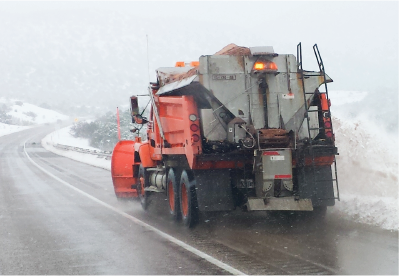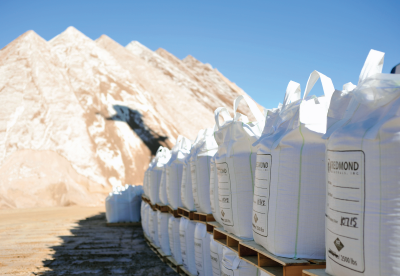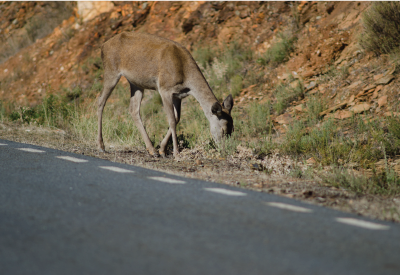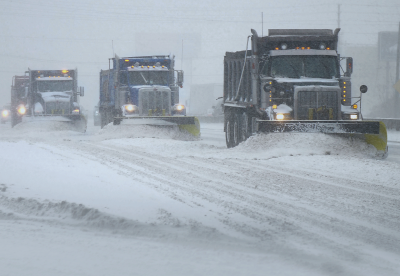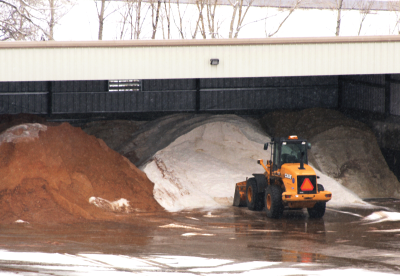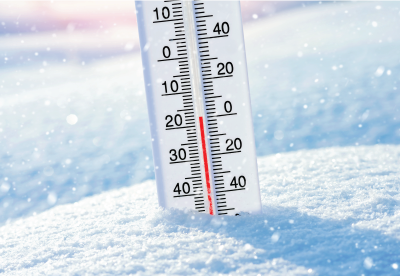Date January 18, 2022 | Brooke Loeffler
What Should a Deicer Do?

Form Brine
Brine formation is the most important factor in deicer performance. When salt and ice melt together to form brine, the bond between the pavement and ice begins to break down. As the brine flows and spreads, it continues to undercut the ice and encourage even more brine formation. Because brine has a much lower freezing point than pure water, it can also continue working long after the deicer has been applied.
Penetrate and Undercut Ice
Deicers should vertically cut through ice and snow to penetrate to the pavement surface. If a deicer’s granules are too small, they will only spread laterally across the ice and snow. The highest performing deicers contain a mix of granule sizes so large grains can penetrate and clear the way for the rest of the granules to immediately begin forming brine directly on the surface of the pavement.

Vertical deicer penetration helps brine form below the ice surface and undercut the ice’s bond with the pavement. A deicer’s contact with the pavement surface increases road traction and also more efficiently wards off continual snow accumulation.
Prevent Re-freezing cycles
It can be extremely frustrating to shovel or plow snow, apply deicer, only to return shortly after and find snow re-accumulating right away. Deicers should immediately get to work forming brine, but also continue to deter ice buildup. Once again, a mixture of granule sizes help deicers act like extended release medicine: small granules for fast acting brine formation, large granules for long lasting brine production.
Stay Where It’s Needed
Deicer performance in a laboratory petri dish pales in comparison to how it truly should perform in the real world. Out in the field, deicers are tossed/thrown/dispersed on a wide range of surfaces with curves, slants, and vertical grades. No matter how well a deicer forms brine, if it bounces and scatters away from where it is needed, it's not doing its job.
Deicer granule size, shape, and surface texture coarseness all play a part in how well it targets the areas that need it most. Reducing bounce and scatter keeps granules where they are needed, improves lane coverage, uses less product, and reduces waste.
Improve Traction
If brine is so important, why doesn’t everyone just pour liquid brine over surfaces that need deicing and call it a day? Brine formation is only part of the equation to restore winter roads and paths to drive-able conditions; the other part is a special kind of friction, traction. The value of using granular deicers is two fold: you are applying 100% active material, and also providing immediate traction. Fortunately granular deicers kill 2 birds with 1 stone and provide both increased traction and brine formation.
Limit Corrosion
Chloride salts in all their varieties, cause some level of corrosion. Metal and concrete infrastructure of a roadway network, as well as the vehicles using it, can be extremely susceptible. One of the best ways to reduce deicing corrosion is to use granular deicers that are naturally less corrosive, or a product with corrosion inhibitors. Choosing a higher performance deicer also allows you to use less product, which reduces corrosion.
Reduce Environmental Damage
Every substance used on our roadways ends up in our environment to some extent. Deicers should look at the whole environment: air, soil, vegetation, animal life, and waterways.
• Click here to learn more about choosing deicers that protect all aspects of the environment.
Those applying deicers should adopt a “less is more” mentality and improve performance in all of the areas mentioned above so that less product is required to restore road safety.
The Ice Slicer® Advantage

Ice Slicer® has been tested and proven by multiple independent labs to work faster and last longer than other granular deicers. It has also been thoroughly field tested to be less corrosive and more environmentally friendly. Click here to see why Ice Slicer® is the best all-around deicer on the market.
© 2024 Redmond Minerals Inc.

